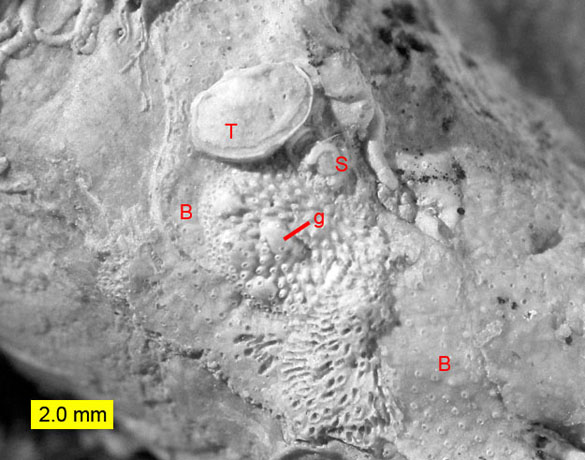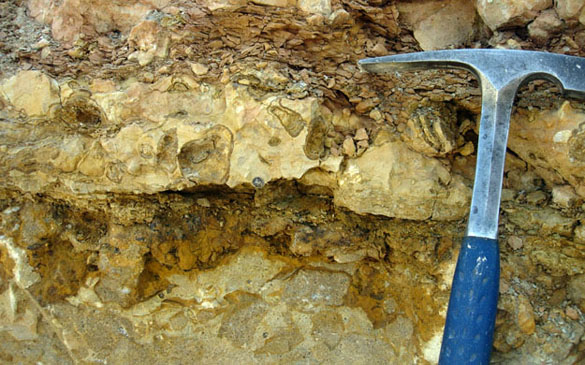
T=thecideide brachiopod; B=cyclostome bryozoans; S=sabellid worm tubes; g=gonozooids on one of the cyclostome bryozoans.
This delightful little community is the subject of a current research project that developed from Independent Study fieldwork in 2006. Elyse Zavar (’07) and I traveled to southern Poland to work on Jurassic fossils associated with a carbonate hardground at the Callovian-Oxfordian boundary near the village of Zalas (the link goes to Elyse’s photographs). With our Polish colleagues we found complex stratigraphy and an even more complex set of fossils. Now Elyse (a graduate student in the great state of Texas) and I have joined with Michał Zatoń of the University of Silesia in Sosnowiec, Poland, and submitted a manuscript describing and interpreting the sclerobionts (hard substrate dwellers) on the large limid bivalve Ctenostreon proboscideum. Michał is the lead author because of his long experience with these fossils and the complicated stratigraphy.

The hardground complex in the Zalas Quarry, southern Poland. It is Callovian below the blade of the well-traveled hammer and Oxfordian above (both stages of the Jurassic).
I have a soft spot for thecideide brachiopods, so they’re the stars of this show for me. I’ve come across them on Jurassic hard substrates many times, so they are old friends. They are filter-feeders like their larger brachiopod cousins, but they cemented one valve to a shell or rock for stability. The bryozoans in this community are also fun, especially when they have gonozooids as imaged above. A gonozooid is a specialized zooecium for brooding eggs and larvae. They are sometimes the only diagnostic features on sheet-like cyclostome bryozoans. There are plenty of serpulid and sabellid worm tubes as well, along with occasional oysters, calcareous sponges, and borings.
We are comparing this Polish Jurassic community to others of the same time interval around the world. Curiously and probably not by chance, a similar sclerobiont assemblage is found in the Middle Jurassic of southern Israel — the subject of another Wooster study.





I can’t help but speculate about the similarity between fossils and ink blots. What you see is partly determined by what is out there and partly by your own expectations and previous knowledge. The problem is minimized when a well-trained research team agrees, but I’m sure you know some examples of shared misinterpretations!
And the best shared misinterpretations are the ones we still think are correct!